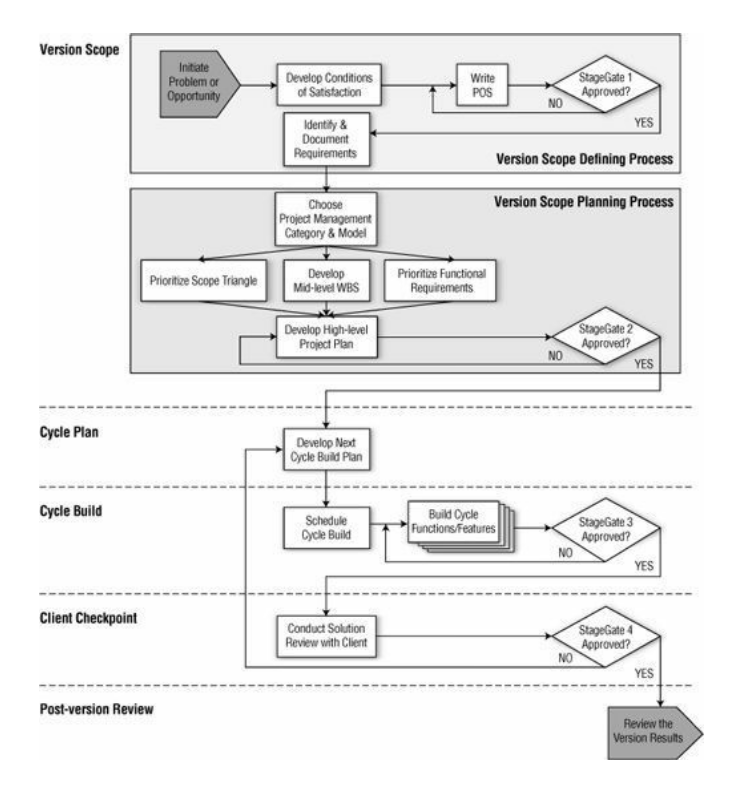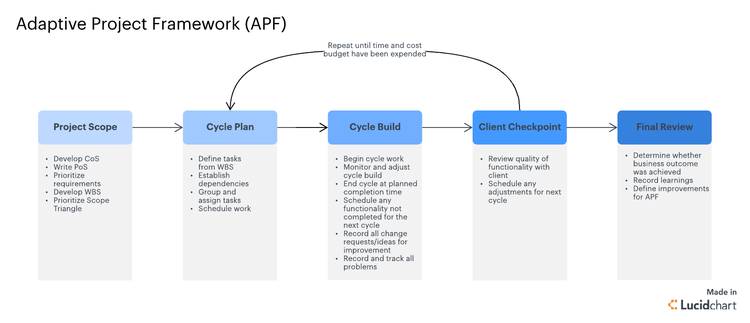The Complete Beginner’s Guide to Adaptive Project Framework (APF)
Many projects have changing requirements, and that’s usually because of one or a combination of several things:
- Changing customer needs and preferences
- Evolving market trends
- Competitor actions
- Accelerating technological change
- Unclear business objectives
Which means they don’t fit the linear, traditional project management approach in which one phase must first be completed before the next one can begin.
We all know the danger and ill effects of forcing a specific project management framework on a project that clearly needs something else -- hence, the increasing popularity of adaptive methods in project management.
One such method is the adaptive project framework or APF, an agile, adaptive approach introduced by project management expert Robert K. Wysocki.
Overview: What is an adaptive project framework?
The adaptive project framework, according to Dr. Wysocki in his book “Adaptive Project Framework: Managing Complexity in the Face of Uncertainty,” came about because of two client engagements with two things in common: “the goals were clearly known, but the solutions were not.”
The majority of today’s projects share the same characteristics, making it difficult to specify a project’s complete requirements, especially initially, which, in turn, makes it difficult to determine the project’s scope.
Insisting on traditional, linear PM frameworks under such circumstances is like fitting “square pegs into round holes.”
The adaptive project framework, in a nutshell, is an iterative and adaptive project planning framework designed to help project managers respond to constant change. APF attributes include the following:
- Requires a mindset that thrives on change
- Not a one-size-fits-all solution and, therefore, adapts to change continuously throughout the project’s life cycle
- Leverages just-in-time planning, in which plans are made when they’re needed instead of weeks or months beforehand
- Follows the “learn by discovery” principle
- Aims to get things right every time
- Focuses on the client’s needs
- Integrates with processes already in place -- such as software development, process improvement, and business life cycles -- instead of the other way around
- Eliminates work that doesn’t add value
The 5 phases of the adaptive project framework
APF’s adaptive life cycle follows five phases or stages.

A flowchart of the five phases of the adaptive project framework (APF). Image source: Author
Phase 1: Version scope
This phase requires meaningful client involvement, and Wysocki advises against starting a project without client commitment. Version scope occurs early in the project and involves representatives from both your organization and the client’s side collaborating to perform these processes:
Version scope definition
Figure out what needs to be done and why. Develop the project’s conditions of satisfaction (COS), which establishes a common language and vocabulary for everyone involved, and an agreement on how to prioritize issues, resolve conflicts, and solve problems.
Then, initiate requirements gathering. At the end of this process, you should have created two types of documents:
- Project overview statement (POS): Usually a one-page document that states the problem, the project’s goals and objectives, acceptance or success criteria, risks, assumptions, obstacles, etc.
- Requirements breakdown structure (RBS): Hierarchical description or breakdown of the project’s requirements
Version scope planning
This process involves these activities:
- Selecting the best-fit project management model (linear, adaptive, iterative, incremental, etc.)
- Understanding which among the project’s constraints (work scope, cost, time, quality, resource availability, etc.) is critical and inflexible, then prioritize accordingly
- Creating a mid-level, as opposed to a full, work breakdown structure (WBS) to develop a reasonable estimate of the time and resources necessary
- Prioritizing the project’s functional requirements against applicable criteria, which can include risk, duration, complexity, business value, and dependencies
- Developing a high-level project plan and submitting it for approval
Phase 2: Cycle plan
In a typical waterfall or traditional project framework, comprehensive project planning is performed before work on the project begins. In APF, high-level planning happens once, followed by detailed planning before each cycle or iteration begins.
In the cycle plan phase, activities include:
- Extracting from the WBS the work that’s relevant for this cycle
- Breaking down the extracted work into tasks, establishing dependencies, and determining the order in which the tasks will be performed
- Identifying resource requirements and assigning tasks to team members
- Establishing task duration
- Finalizing the cycle schedule
Cycle plan is the first of three phases performed repeatedly -- called the APF cycle -- until the project is complete. The APF cycle also includes cycle build and client checkpoint.
Phase 3: Cycle build
Now that you have a plan, it’s time to put it into action. The cycle build phase includes these activities:
- Commencing work
- Monitoring for scope changes and making necessary adjustments
- Stopping work when the allotted cycle time is over, which means all uncompleted work will be reconsidered in the next cycle
- Tracking and recording all change requests and ideas for improvement
- Logging all issues and tracking their resolution statuses
Phase 4: Client checkpoint
The client checkpoint phase is a critical juncture in the life of an APF project. It also marks the end of an APF cycle.
In this phase, the project team, with the client or their representatives, will review the functions and sub-functions of the deliverable just completed. The lessons learned from the review will dictate the tone and direction of the next and succeeding APF cycles.
This phase requires these inputs:
- Planned vs. actual features and functions added
- Learning and discovery results
- APF scope bank, which is a repository of all features, functions, ideas, and requested changes that haven’t been fully addressed yet
- Scope bank status reports
- Updated RBS
Phase 5: Post-version review
Once a project is complete, it’s time to perform a post-mortem analysis.
- Check whether the project succeeded and satisfactorily met its goals and objectives. Questions to ask include: Was the solution acceptable? Did it meet the project’s success criteria? Is a second version recommended?
- Next, determine which features to add to or remove from the next version.
- Identify process improvements and collect best practices for future APF projects.
The post-version review also signals that work on the current version of a solution has been concluded.

Here’s another look at the five APF phases. Image source: Author
Think like a chef with APF
To succeed at APF, an analogy Dr. Wysocki uses throughout his book is “to think like a chef and not like a cook.” He argues that cooks only follow recipes someone else wrote and find themselves lost when an ingredient the recipe calls for is missing, while chefs adapt and work with what’s available.
In the same vein, since all projects are unique, the skills, approach, project management tools, and technology (e.g., hardware, project management software, templates, etc.) that you choose to support them should align with their unique needs and circumstances.
APF is an agile, adaptive planning approach that requires outside-the-box thinking and creativity and, therefore, worth considering when working with complex projects filled with uncertainties.
Alert: our top-rated cash back card now has 0% intro APR until 2025
This credit card is not just good – it’s so exceptional that our experts use it personally. It features a lengthy 0% intro APR period, a cash back rate of up to 5%, and all somehow for no annual fee! Click here to read our full review for free and apply in just 2 minutes.
Our Research Expert
We're firm believers in the Golden Rule, which is why editorial opinions are ours alone and have not been previously reviewed, approved, or endorsed by included advertisers. The Ascent does not cover all offers on the market. Editorial content from The Ascent is separate from The Motley Fool editorial content and is created by a different analyst team.
Related Articles
View All Articles